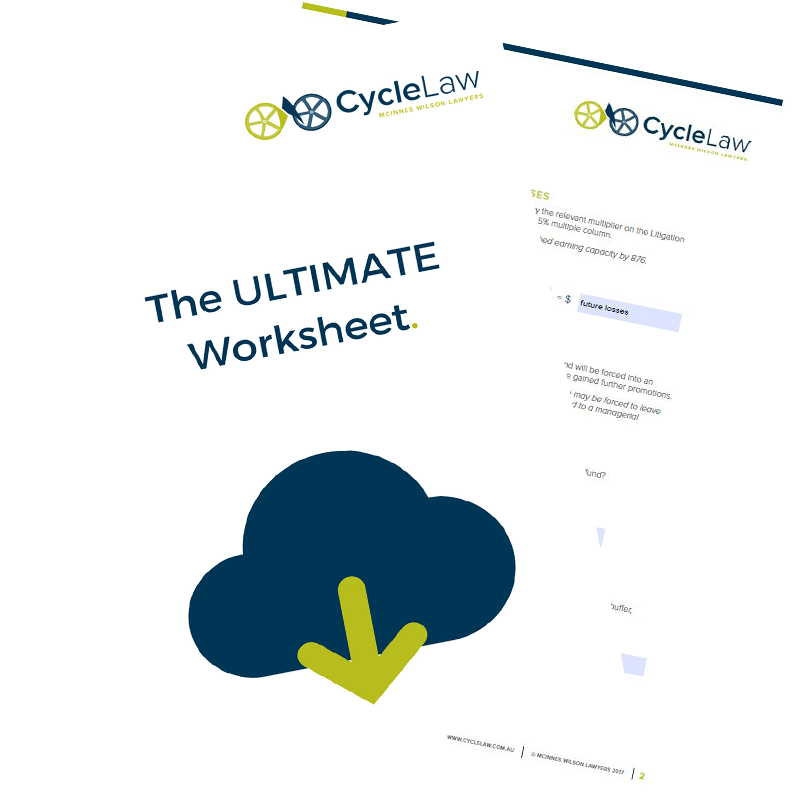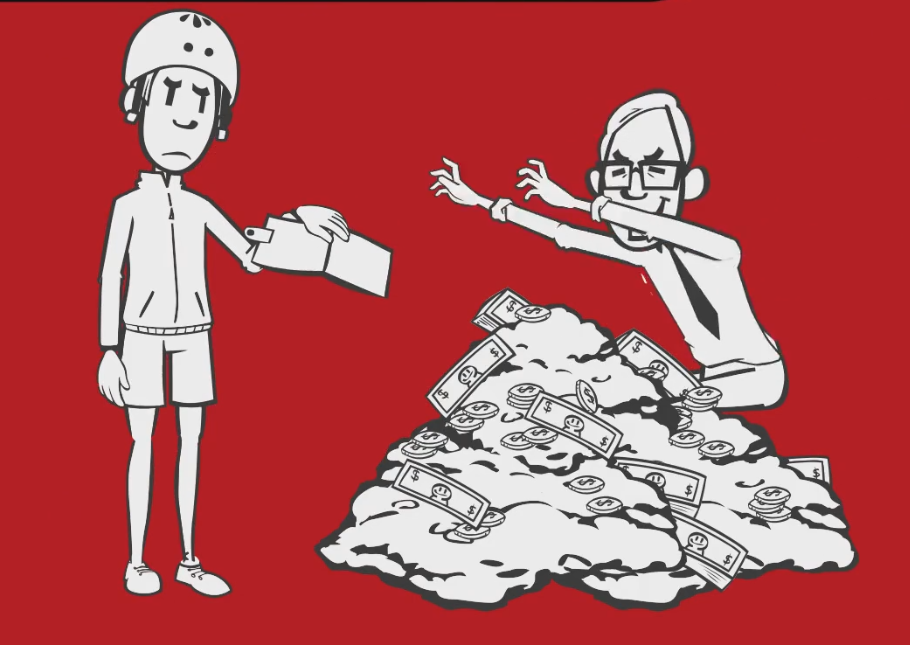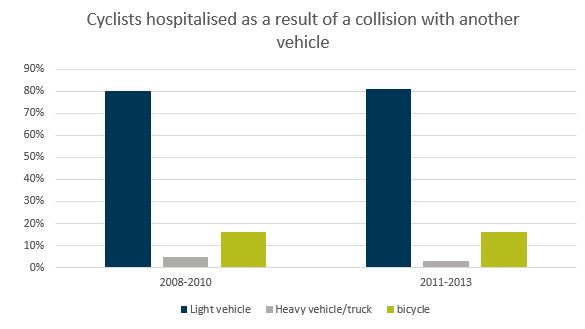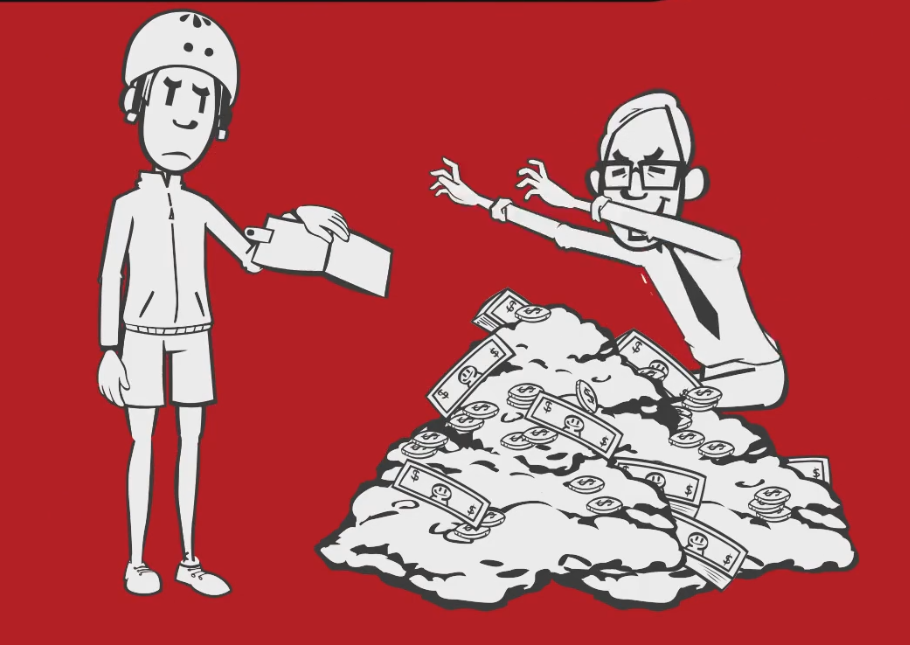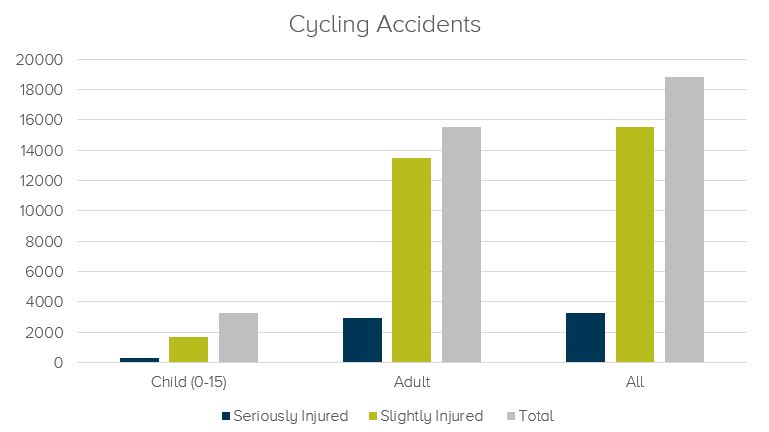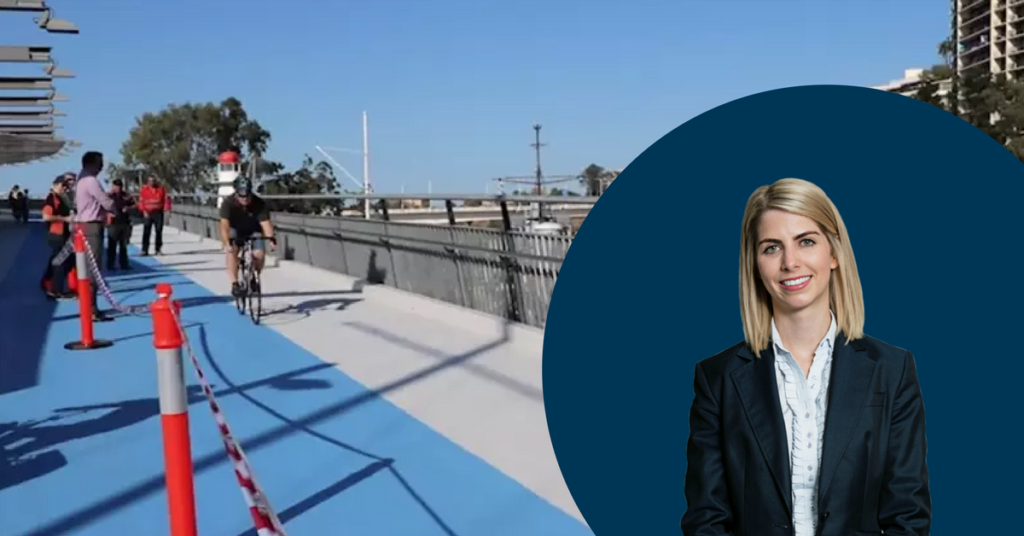
“The government has knowingly left a substantial hazard for cyclists. Every time it rains a new cyclist is injured. In our opinion, something needs to be done”
Emily Billau - Principal Cyclelaw
The Goodwill Bridge – it’s probably one of the busiest cycle routes in Brisbane and now it’s become unsafe.
We represent far too many clients who have placed their trust into normally safe public infrastructure only to find out the hard way that the surface is unreliable. And unfortunately these hazards can have devastating and lifelong effects on the cyclists and their families.
The current state of the Goodwill Bridge surface needs urgent and prompt attention before there are too many more serious injuries.
What's the situation?
Late last year, work had taken place on the Goodwill Bridge to fix the slippery surface after complaints of accidents.
Despite appearances, the upgraded blue surface is still a hazard causing cyclists to lose traction and sustain significant injury, even at really low speeds.
In response to fresh complaints, this month, the government has installed caution signs on the entrance to bridge instructing cyclists to “dismount when wet”.
The bridge remains a dangerous hazard to cyclists.
Asking cyclists to 'dismount when wet' is really just shifting the responsibility.
The authorities, not the cyclists, are responsible for rectifying the dangerous surface.
Emily Billiau
Principal, Cyclelaw
Does the State owe cyclists a duty of care?
Emily Billiau
Principal, Cyclelaw
Yes.
The State does owe cyclists who use the Goodwill Bridge path a duty of care.
If they breach that duty of care they may be liable to compensate the cyclist.
Evidence (including likely expert evidence) would ultimately need to be obtained to support a case in negligence against the Sate and/or their contractors, servants or agents.
But for now, our preliminary thoughts are this...
We would argue that the surface:
- appears to not have a sufficient and/or appropriate slip resistance;
- is such that it was sufficient to cause a number of cyclists to lose traction when wet;
- is frequently used by cyclists and it was known to the State Government that this was the case;
- until recently, was not marked, barricaded or covered in any way to identify the hazard;
- in the circumstances, presented a perpetual trap, such that it could not be detected by cyclists in time to avoid an accident.
We would say that the existence of the surface created a specific hazard which posed a foreseeable risk of injury to cyclists.
The State Government were and still are aware of growing issues with the slipperiness of the bridge.
There have been at least nine report of accidents since its resurfacing and countless more prior to that.
Ultimately, in our opinion, the State have failed in their duty of care to cyclists
by:-
- failing to provide a safe surface for bicycle traffic;
- failing to remove the hazardous surface from the path when it knew of the hazard;
- failing to implement an appropriate remedial solution;
- failing to construct the path is a reasonably competent manner;
- causing, allowing or permitting the use of the path, in circumstances when they knew, or ought to have known, that it was a hazard to cyclists;
- failing to give any, or any adequate, warning of the surface or the hazard.
What this could cost the authorities
If someone (a cyclist) is owed a duty of care by the State
- and the State breaches that duty of care to them (bad path surface)
- and these people have suffered loss (damages)
- these angry cyclists may very well form a long line at the court house seeking hundreds of thousands (if not millions) in compensation.
Surely it is just much easier, and cheaper, to put down a non-slip surface over a 400 m bridge?
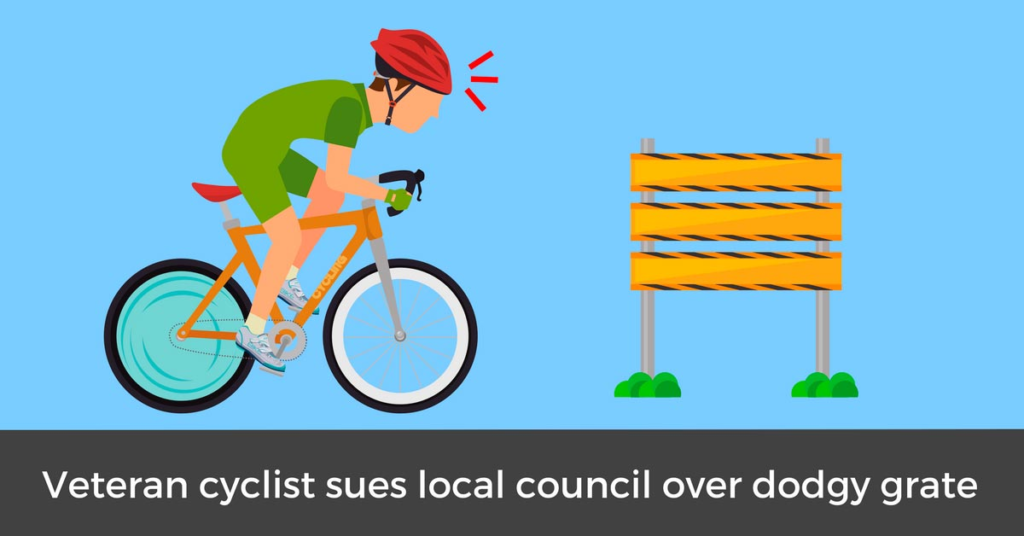
A passionate cyclist who became a quadriplegic after his bicycle wheel got caught in a treacherous drainage grate is suing Mornington Peninsula Shire (Victoria) for negligence, the Mornington Leader reports.
Before the accident, Gerry Russell – a fit and healthy seventy year old – was enjoying his retirement doing the things he loves: skiing, yachting and riding. Previously a physical instructor in the Royal Navy, Mr Russell used to ride up to 400 kilometres a week before he was flung from his bicycle on 15 September 2015. Now, Mr Russell has lost movement in 98 per cent of his body.
Mr Russell is suing the Shire for pain, suffering and loss of income.
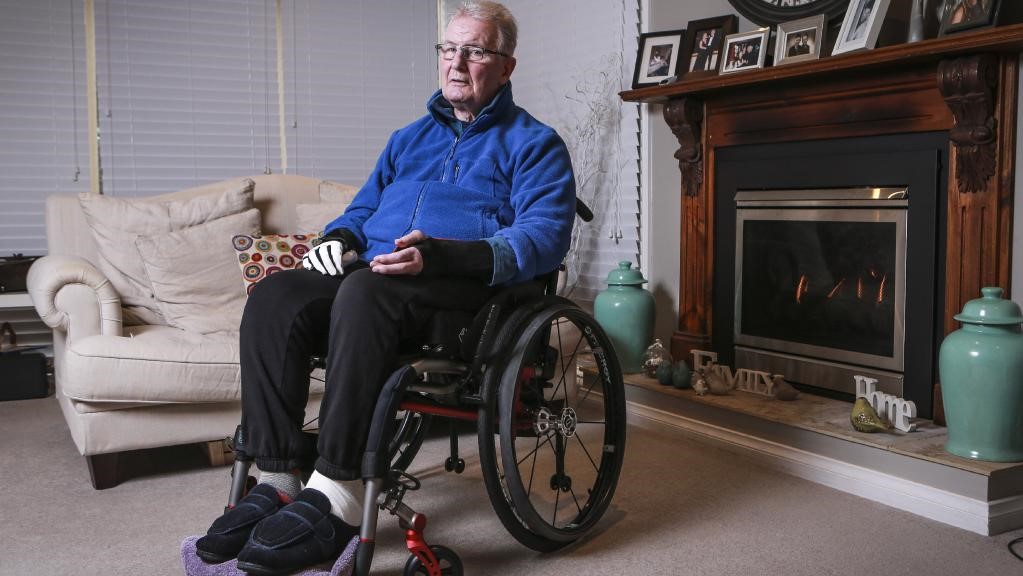
Mr Gerry Russell (Source: Herald Sun)
Don't read this unless...
You are wondering how the Courts calculate compensation, download this free 'Economic Loss Worksheet'. Discover the simple calculations that will estimate the value of any compensation claim in 10 minutes.
[h2_heading]The Facts[/h2_heading]
Mr Russell told a local Mornington newspaper that he was cycling along his usual route, when he carefully moved to the side of the road to allow a car to pass.
“Then my wheel stuck and I flew over the handlebars — I was wearing a helmet so that took the brunt of the force, but I snapped my neck,” he said.
“As soon as I came to, I tried to move and realised straight away that I couldn’t.”
Mr Russell’s wheel caught on an old drain – thousands of which remain in place across the shire.
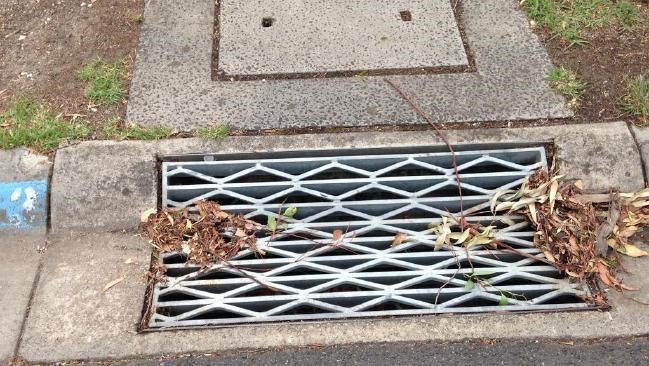
Example of the old grates in the area (Source: Herald Sun)
Misaligned drainage grates have caused multiple riders to crash in recent years. According to Mr Russell, at least three other cyclists he knows have been injured in similar accidents. Local cyclists are urging the council to replace the old drains.
[h2_heading]The Outcome[/h2_heading]
There is no current estimate for the compensation sought by Mr Russell. The case is listed for trial in May 2018.
However, local councils across Australia are granted a certain level of protection against claims like this. This is because it is simply impossible for local councils to ensure all roads are in good condition at all times.
The Civil Liability Act 2002 provides that road authorities are not liable for accidents arising from a failure to carry out or consider road work, unless the road authority had actual knowledge of the issue which caused the accident.
This means that Mr Russell will need to prove that Mornington Peninsula Shire knew that the grates were a risk.
Don't read this unless...
You are wondering how the Courts calculate compensation, download this free 'Economic Loss Worksheet'. Discover the simple calculations that will estimate the value of any compensation claim in 10 minutes.
[h2_heading]The Consequences[/h2_heading]
If you are injured due to someone else’s negligence, you may be eligible to receive compensation for your injuries. However, you must prove that the local council responsible for the road knew (or should have known) of the problem.
Usually, this requires evidence of previous complaints made to the local authority about the road to prove the Council knew the hazard existed. Evidence that the Council had recently inspected the road, or had not inspected the road in a long time, is also useful.
If you notice an issue with the road, you should contact Council. If another cyclist is injured because of that same issue, your complaint will be very useful evidence for their claim. Take care, and look out for your fellow riders.
Written by Emily Billiau | Principal
IF YOU HAVE MORE QUESTIONS, GIVE US A CALL.
Most queries can be answered easily in under 15 minutes.
IF NOW IS NOT A GOOD TIME TO CALL...
Give us your contact details and we can ring you back to answer your questions. It's free.
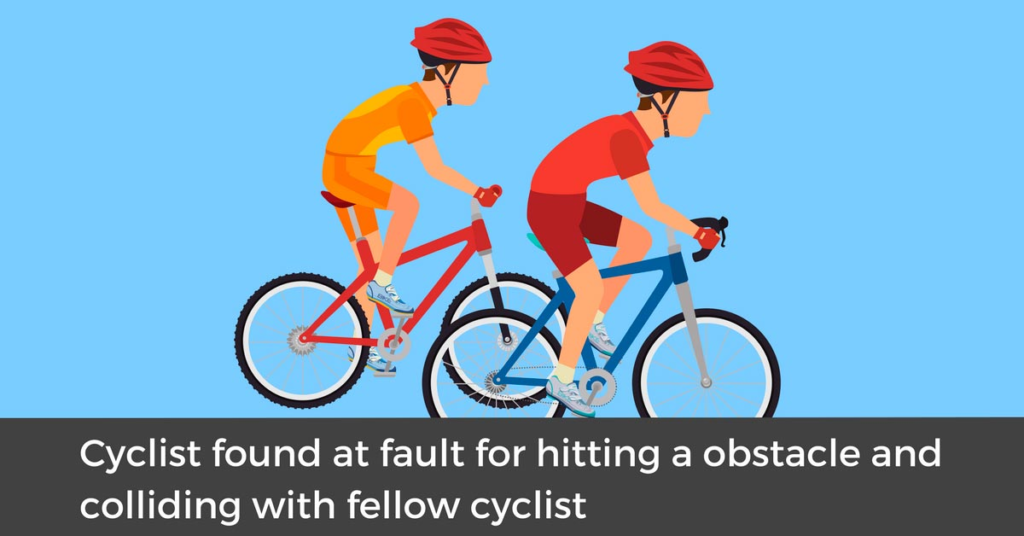
The Facts
Michael Franklin lived in Canberra and rode his bicycle to and from work each day. He regularly rode home from work with his friend, David Blick.
At about 5.30pm on 17 June 2009, Michael and David left work on their bicycles. They were riding in a bicycle lane which ran alongside the roadway of Commonwealth Avenue and Capital Circle in Canberra. It was already dark but both bikes were fitted with powerful lights and there was good lighting in the area. There was a heavy flow of traffic alongside the bike path, as it was around peak hour.
Michael and David were riding at about 25 kilometres per hour. David was riding slightly in front of and to the left of Michael. David’s bike hit a piece of wood approximately 2 metres long that was lying in the bicycle lane directly in his path of travel.
When his front wheel struck the wood it caused his wheel to slide out from under him. David and his bicycle fell towards Michael. Their wheels locked together causing them to fall from their bicycles. Michael was thrown onto the roadway and directly into the path of oncoming traffic. He was run over by a motor vehicle. He attempted to crawl off the road following the accident but could not move his legs.
Michael sustained severe injuries in the accident including a fractured pelvis, a fracture to his lower back, internal bleeding, severe bruising and abrasions. Michael spent 28 days in the hospital and underwent surgery to his pelvis.
An external fixator was attached to his pelvis and protruded 10cm from his body where it was attached to rods. When Michael left the hospital he continued to suffer severe pain and infections from the device. The screw inserted into his body impinged on his sciatic nerve causing him severe pain. The screw was subsequently removed in 2012 but Michael continued to suffer ongoing pain in his lower back. He had to undergo extensive treatment up to the date of the trial.
The injuries affected Michael in his employment as an Applications Developer. Following the accident, he had to halve his working hours to an average of 25 hours a week with ongoing time off work due to his symptoms.
Want to know how to stop lawyers overcharging?
Watch our step-by-step video guide and discover:
- How lawyers charge
- Where and when you can negotiate your costs
- How to save yourself tens (even hundreds) of thousands of dollars in legal fees
Not watching the video may be the most expensive mistake of your life.
There was no evidence to suggest that the motor vehicle driver was at fault for running over Michael. Michael, therefore, sued David for failing to keep a proper lookout for dangers on the bicycle path and failing to avoid a collision with Michael.
David denied he was at fault for the accident. He argued that Michael should not succeed because David’s duty to Michael was only to take reasonable care in all the circumstances and he did that. He also argued that Michael contributed to the accident by failing to take proper care for his own safety whilst riding his bicycle.
Bicycle Accident Statistics
This situation is not unheard of. The graph below was produced by the Department of Infrastructure and Regional Development and shows the hospitalised injuries for cyclists from 2008 to 2010 and from 2011 to 2013 involving other vehicles including bicycles.
The data reveals that 85% of cyclist hospitalisations involved another vehicle (mostly a light vehicle) however 1 in every 6 cycling accidents were due to a collision with another cyclist.
This clearly shows that collisions between cyclists resulting in hospitalisations are more common than you might think.
The Judgment
The matter was heard in the Supreme Court of the ACT by Justice Burns.
Who was at fault for the accident?
Justice Burns heard evidence from Michael and David in relation to the circumstances of the accident.
There can be no doubt that the defendant owed other road users, particularly cyclists such as the plaintiff, a duty of care to exercise reasonable care to avoid causing injury to other road users. In my opinion this duty extends to exercising reasonable care to avoid running over objects on the cycleway likely to cause him to lose control of his bicycle.
Award for damages
Justice Burns believed Dr Le Leu was the person most qualified to give evidence in relation to Michael’s working hours. He accepted his evidence over the evidence from David’s orthopaedic surgeon and neurologist. Justice Burns was satisfied from that evidence that Michael would only be able to work 25 hours a week until his retirement age of 67 years.
He awarded Michael $1,659,392.75 in damages. Of that award, $335,000.00 was awarded for loss of wages to the date of trial and $838,925.75 of that award related to his future loss of earnings to retirement.
Cycle Law's Opinion
Medical Evidence
This case resulted in a very good outcome for Michael. The fact that Michael obtained expert advice from an occupational physician was crucial to the successful outcome of his claim. The judge accepted the evidence of the occupational physician and awarded him compensation on the basis of that evidence.
David did not provide any evidence from an occupational physician/therapist. Because of that, the judge accepted Michael’s medical evidence over David’s medical evidence. Michael’s claim for loss of earnings represented a major component of his claim for damages.
Fault for the Accident
Cyclists often travel in groups and ride closely together. That is the nature of cycling however it is important to remember that as a cyclist you have to exercise reasonable care to avoid causing injury to other road users. This extends to other cyclists you may be riding with. This case shows the importance of cyclists keeping a careful lookout for any obstacles in their path of travel so they can take evasive action to avoid causing injuries to other cyclists.
The Consequences
The importance of obtaining the correct medical evidence
It is important in any case to ensure you obtain the correct expert evidence. If your work has been affected by the accident then it is crucial to obtain a report from an occupational physician/therapist.
If you have that evidence to support your claim you are more likely to be awarded damages for loss of earnings in the past and future.
The importance of cyclists obtaining public liability insurance
In the case outlined above, Michael’s compensation was paid out by David’s insurer. Although claims are lodged against the rider that caused the accident they are likely covered by public liability insurance either through the other party’s house and contents insurance or through bicycle insurance. This means that although someone might be suing their fellow cyclist, any compensation that’s awarded will be paid by the insurance company and not the cyclist.
Written by Emily Billiau | Principal
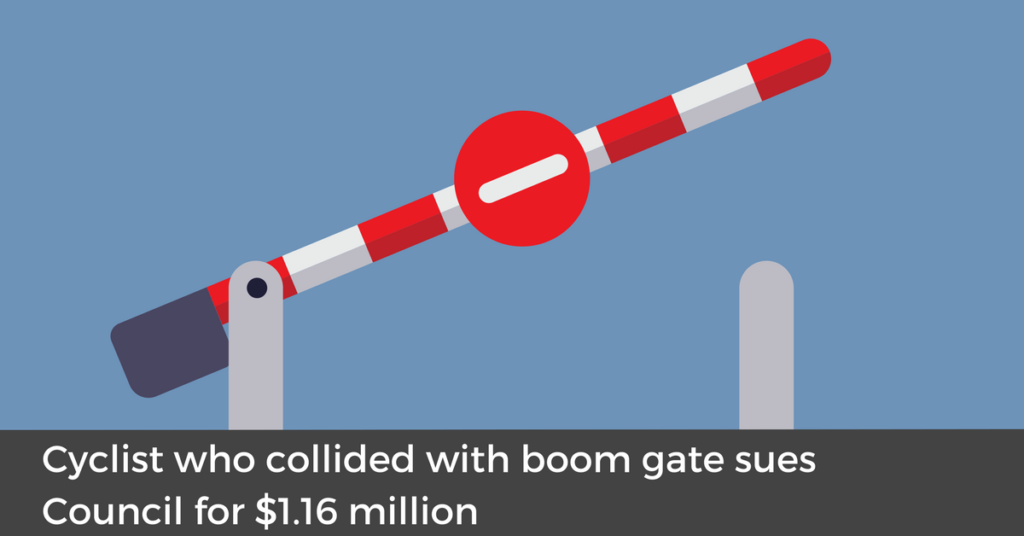
Champion cyclist Alex Simmons had trained daily on the same stretch of bike route through an open boom gate near the St George Sailing Club.
The cycle route was used frequently by thousands of cyclists and there was an expectation that the boom gate would be open – because it always had been.
Until the morning of 11 April 2007 when someone forgot to open the gate.
Riding about 30km/h, Mr Simmons had no time to brake and smashed into the steel beam of the gate.
The gate was difficult to see and had no signs to alert of an obstruction ahead, meaning the gate essentially came “out of nowhere”.
Tragically, Alex’s injuries were so severe that surgeons were forced to amputate his left leg beneath the knee.
The New South Wales Rockdale City Council had constructed the boom gate to enclose a stretch of road that was adjacent to the sailing club’s car park to stop “hoons doing burnouts”.
Despite the sailing club having an informal agreement with the Council allowing them to lock and unlock the gate at its discretion, the Council had legal authority and control over the boom gate.
To make matters worse, two fellow cyclists had also had a collision with the closed boom gather in similar circumstances. One even alerted the Council to the hazard and was told it was simply a ‘freak accident”.
Mr Simmons brought a claim against the Council, stating they were aware of the hazard and owed Alex and other cyclists a duty of care in ensuring the route was safe.
Want to know how to stop lawyers overcharging?
Watch our step-by-step video guide and discover:
- How lawyers charge
- Where and when you can negotiate your costs
- How to save yourself tens (even hundreds) of thousands of dollars in legal fees
Not watching the video may be the most expensive mistake of your life.
The Issues
The Court had to consider the 4 critical issues:-
- Whether there was a duty of care owed by the Council to Mr Simmons (that is, the responsibility to ensure the safety or well-being of Mr Simmons);
- Whether the Council breached its duty of care to Mr Simmons;
- Whether the Council’s breach caused injury to Mr Simmons;
- Whether Mr Simmons in any way contributed to the incident and his injuries (for example through his speed or by failing to observe the gate).
The Decision
Mr Simmons argued that the gate presented a “perceptual trap”, such that he wasn’t able to detect that the gate was closed in time to avoid the collision.
He said that the Council was aware that cyclists used Riverside Drive often through the entrance to the car park which was closed by the boom gate.
The Council denied that they were liable. They argued that Mr Simmons had alternative options available to him to exit the car park and that Mr Simmons failed to take care for his own safety.
Justice Peter Hall of the Supreme Court did not agree, finding that Mr Simmons “could not, and did not detect the boom gate… until it was too late to avoid it”.
The Court criticised the Council for relying on a lax agreement with the sailing club for the cleaner to open the boom gate daily across one of the city’s most popular cycle routes.
Justice Hall said that “in the event [that] the cleaner failed to attend on any day (for any reason) to open the boom gate, the system carried a foreseeable and an inherent risk of failure”.
Justice Hall found that the Council knew that the boom gate presented a hazard and that the system to open the boom gate had failed on multiple occasions. Evidence presented at court highlighted the Council were aware of two additional accidents with the closed boom gate that had occurred in the months prior to Alex’s accident.
Furthermore, it was found that the likelihood of an accident occurring causing serious harm was high as the Council had failed to warn cyclists of a potential obstacle ahead.
However, for Mr Simmons to succeed, he had to overcome a number of evidentiary hurdles.
Evidence had to be collected to prove that the Council owed him a duty of care and that they breached this duty of care.
This included:-
- Evidence of traffic signs in the area;
- Evidence of the Council’s knowledge of the hazard;
- Evidence about alternative routes available to Mr Simmons;
- Evidence of the Council’s responsibility for the boom gate;
- Evidence that he could not have seen or detected the boom gate before it was too late.
Alex was successful.
The Council was held liable and ordered to pay him $1.16 million in compensation
The compensation awarded to Mr Simmons was calculated by reference to the impact the injuries have had on him and the impact they will have on his future earnings and domestic needs.
What does this mean?
The number of people riding today is phenomenal - and the numbers continue to rise…
Unfortunately, the potential for injury to a cyclist is ever present (whether that be from other road users or public/council hazards).
Recent statistics published by the Royal Society for the Prevention of Accidents in the UK show that about 17% of cyclists sustain serious injuries when involved in an accident.
This case sets a great precedent for claims against Councils.
It confirms that Council’s do owe cyclists a duty of care and that if they breach that duty of care they may be liable to compensate the cyclist.
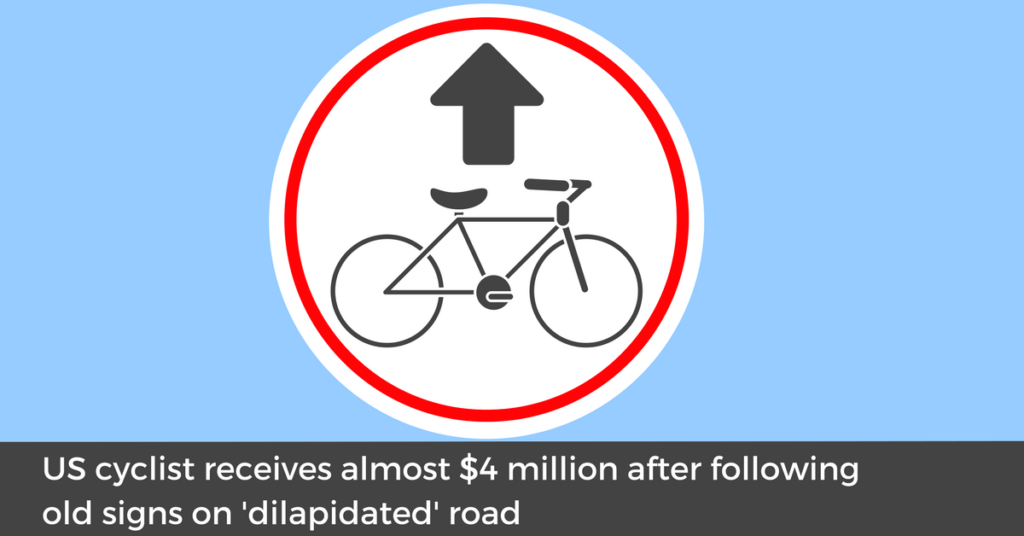
The Summary
A Rabbi who suffered permanent traumatic brain injuries after his bicycle was struck by a car has received US $3 million (AUD $3.77 million) in compensation.
Shelaim Furst was riding his bike along Victory Boulevard, San Fernando, USA on 25 August 2010 when Antoine Shehata tried to change lanes behind him, the LA Times reports. Rabbi Furst hit Mr Shehata’s vehicle’s windshield and was thrown 27 feet (8 metres) into the street.
The Rabbi sustained a brain injury and memory loss.
In previous years, Victoria Boulevard was a designated bicycle route. By the time of the accident, it was no longer used for those purposes. But the bicycle route signs remained in place while the route was left to fall into disrepair.
It was alleged that the city of Los Angeles had allowed Victory Boulevard to fall into “dilapidated” conditions, and had created a false sense of security for cyclists by leaving bike route signs in sight.
The L.A. City Council decided not to fight the matter in Court, and instead agreed to the US $3 million settlement without any discussion.
Queensland Cyclist Rights vs Californian Cyclist Rights
Before the histrionics start that Australia is becoming a litigious society like America, let us remind you of the differences. For example, parties that lose a case like the one outlined above do not have to pay legal costs in America. In Australia, the losing parties are required to pay these costs and often the costs of the winning party. Typically, this means bogus or weak cases that are unlikely to stand up in a Queensland Court are never pursued. So for a case to get up in Australia means that a Judge has considered the defence lawyers argument to be weaker than the claimants argument
In this instance, the Rabbi sued the local Council rather than the driver. Although not reported, it is widely speculated that Mr Shehata’s (the negligent driver) insurance policy was not sufficient to cover the compensation required by the Rabbi, or was not insured at all.
The case would be different in Queensland, where drivers are required by law to have CTP insurance. Therefore, if any claims would be against the driver of the at-fault vehicle (or their insurer).
If you are struck by an uninsured vehicle in Queensland, your claim can still proceed against a body called the Nominal Defendant. The Queensland Government created the Nominal Defendant in 1961, so that persons injured by unidentified or uninsured drivers could still seek compensation. The Nominal Defendant is funded out of the compulsory third party system.
Had the Rabbi fallen because of the ‘dilapidated’ conditions, only then would he have been able to raise a claim against the local council.
What this means for Queensland cyclists
If this case occurred in Queensland, and it was the case that the driver was uninsured, the claim for compensation would likely have proceeded against the Nominal Defendant. However, the Nominal Defendant would have recovered its costs from the driver.
This claims process is very similar to the process for claiming compensation from a third party insurer.
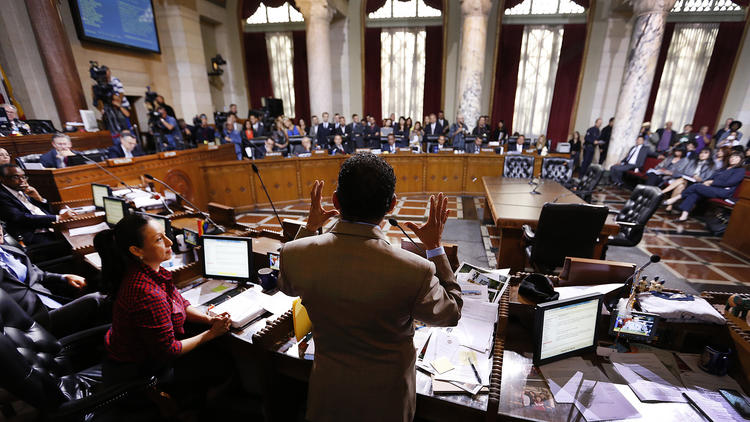
- Los Angeles City Council in 2015 (Source: LA Times)
Written by Claire McHardy | Solicitor
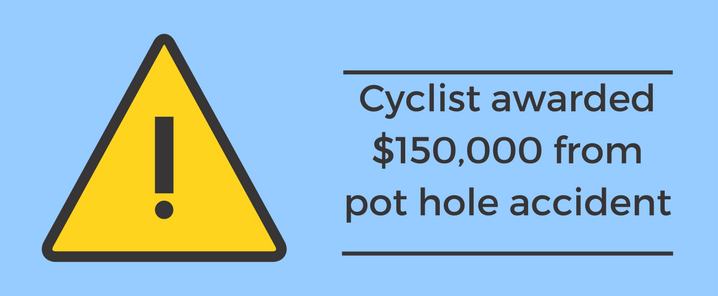
[h2_heading]The Facts[/h2_heading]
Tom was cycling along a main Brisbane road with his mate. As a professional athlete, he had taken this route many times before. However, on this particular day, Tom struck an uneven section of the road and was thrown from his bicycle.
Tom injured his spine and pelvis, and the bitumen left his skin torn and bruised.
From a distance, the deformity in the road was hard to see. But it clearly posed a risk of serious injury to cyclists.
Tom had to give up the sport he loves so dearly, as well as the sponsorships and prize money that came with his success. Instead, he had to focus on a rehab program and get a desk job.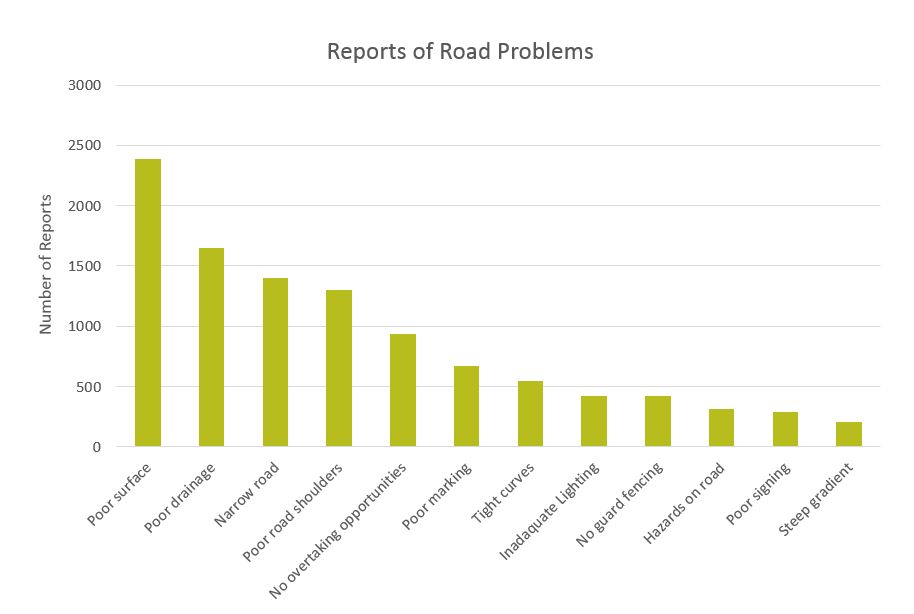
Tom now suffers through persistent tightness and pain at work. He may not be able to put in the hours he needs to to get promoted. He will probably also require commercial assistance in future. Tom’s life has been changed because of this accident.
[h2_heading]The Outcome[/h2_heading]
We argued that the local Council knew about the problem with the road. There was evidence to show the Council had meant to have the roadway fixed months before Tom’s accident.
Importantly, Council tried to argue that Tom had been cycling at speed. Tom’s mate was able to back up Tom’s claim that he was only travelling at about 35km/hr.
After some negotiations, Tom settled his claim outside Court. Council paid $150,000.00 in damages.
Don't read this unless...
You are wondering how the Courts calculate compensation, download this free 'Economic Loss Worksheet'. Discover the simple calculations that will estimate the value of any compensation claim in 10 minutes.
[h2_heading]Cycle Law’s Opinion[/h2_heading]
This was a great outcome for Tom. It meant that he did not need to go through a lengthy trial.
The amount was calculated by reference to the impact the injuries will have on his future earnings and the care he will require, amongst other things. It is important to note that each unique set of circumstances will have a different outcome.
For Tom, although he had to give up his dream of cycling for Australia, the compensation he received meant he was able to get on with his life as soon as possible. Tom has now found a new career he loves.
However, claims like Tom’s are difficult to run. Local Councils have a limited amount of funds, and cannot be expected to keep every road in tip-top condition at all times. Instead, Council’s prioritise the roads that need fixing. To win a trial like this, you would need to prove that Council knew or ought to have known about the issue, and had the funds to fix it.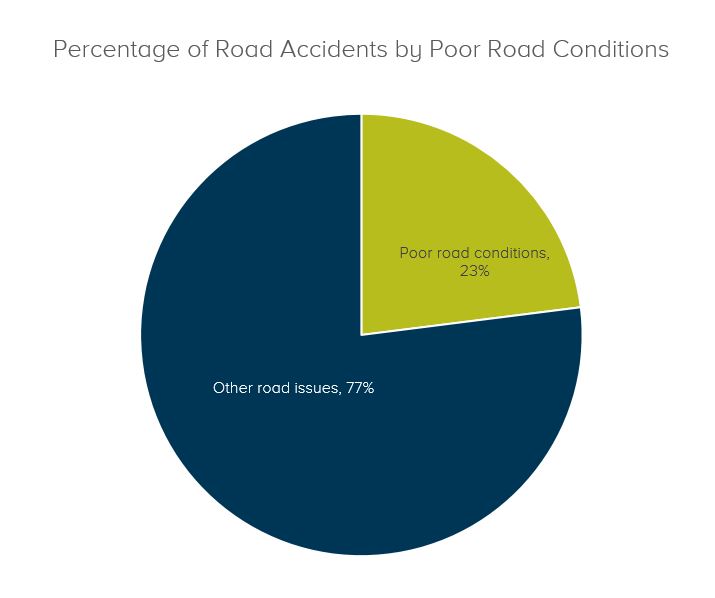
It is also important to collect evidence from the day of the accident.
There are four pieces of evidence that are vital for proving the Council is at fault:
- Strava data (GPS tracking of your ride)
- Pictures of the road
- Pictures of the injuries are all helpful
- Written notes or recordings of what happened at the time of the accident
This is especially important if no one saw what happened. If Tom’s matter had gone to trial, strava data of his trip that day would have been vital.
[h2_heading]The Consequences[/h2_heading]
Tom’s claim shows that it is possible to get a good outcome for cyclists unlucky enough to strike a pothole, shove or uneven road surface and sustain an injury. If this happens to you, it is important that you gather as much evidence as you can from the scene.
Written by Claire McHardy | Solicitor
IF YOU HAVE MORE QUESTIONS, GIVE US A CALL.
Most queries can be answered easily in under 15 minutes.
IF NOW IS NOT A GOOD TIME TO CALL...
Give us your contact details and we can ring you back to answer your questions. It's free.

Carmen Greenaway, a New Zealander living in London was riding home after her mother’s birthday party.
She wasn’t wearing a helmet.
Her mother, riding 100 metres behind, saw her daughter hit an uneven part of the road, catapulting her out of the saddle, her head hit the ground hard, cracking her skull. She was holding the handle bars with one hand.
She died.
Everyday people are taking massive risks without wearing a helmet, despite it being illegal and all the scientific evidence pointing to the fact that it could save your life in an incident like Carmen’s.
At Cycle Law, we provide specialised legal advice to Queensland’s cycling community through Bicycle Queensland and we continually see some terrible accident injuries but we also see how the compulsory helmet has helped save lives. Why the same legislation isn’t in place or enforced around the world is very surprising.
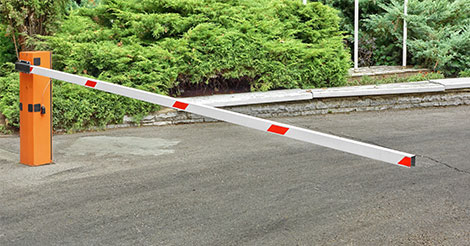
A Popular Cycling Route and the Boom Gate
The Plaintiff was a competitive cyclist who was out on an early morning training ride. The Plaintiff’s ride took him along Riverside Drive in front of the St George Sailing Club (the Club), where he collided with a closed boom gate and sustained serious injuries. The boom gate had been installed by the Council after issues with ‘hooning’ had arisen in the carpark at night.
The Council had entered into an informal agreement with the Club, allowing them to open and close the gate ‘at their discretion.
The Council’s case was that the collision had occurred as a result of the Plaintiff’s own negligence. The Council pleaded that:
- It was an obvious risk of engaging a dangerous recreational activity (cycling); and
- That the Plaintiff had failed to keep a proper lookout; and
- That the Plaintiff was riding in a direction opposite to marked traffic flow; and
- That the Plaintiff failed to ride at an appropriate speed; and
- That the Plaintiff ignored ‘no exit’ signs
Evidence lead at the trial of the matter demonstrated that the Council was aware of two earlier incidents occurring when the boom gate had been left closed early in the morning and cyclists had subsequently collided with it. There was also evidence that Riverside Drive had, for many years, served as an extension of a popular cycling route and cyclists would frequently ride through the point where the boom gate was erected.
The Plaintiff was ultimately successful in his claim, although a finding on contributory negligence was made by the Court. The Court found that the Plaintiff cyclist contributed to his injuries Judgement was entered in favour of the Plaintiff in the order of $928,000.00 (after a 20% reduction for contributory negligence) on the basis that the council owed a duty of care to regular users of the Riverside Drive, such as cyclists, and should have taken reasonable steps to ensure that the boom gate did not become a hazard. They failed to take appropriate action by not having a system in place to ensure that the gate would be opened by a specific time each day, did not make the boom gate readily visible and provided no safe alternative access to the street.
By Emily Billiau and Gemma Sweeney







